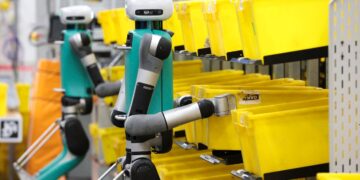TOPSHOT – Bipedal robots in testing phase move containers during a mobile-manipulation demonstration … [+] at Amazon’s “Delivering the Future” event at the company’s BFI1 Fulfillment Center, Robotics Research and Development Hub in Sumner, Washington on October 18, 2023. (Photo by Jason Redmond / AFP) (Photo by JASON REDMOND/AFP via Getty Images)
As I was composing this article, I wondered if it would be easier to write what NOT to expect in AI in 2025, rather than what to expect! For a technology that appears to be advancing in almost every area at the same time, how does one even pick 5 areas? To narrow the scope a bit and hopefully make it more interesting, I decided to select trends that are not directly about the growth of ChatGPT or its competitors. It is safe to say these will grow, and these apps and the companies behind them will do their best to make these applications the solutions to every problem possible.
So what else remains? Here are 5 trends, in no particular order:
AI Trend 1: Agents Everywhere
You may have heard the term Agentic AI. While AI was always about learning patterns, the stages that AI has evolved into are (a) learning patterns from data (b) generating new content based on these patterns and (c) taking actions based on these. It is when all three of these come together that you have an AI agent – a piece of software capable of learning, creating actions, and executing them. Expect to see a lot more development in this area in 2025.
AI Trend 2: Transformation Of The Education System
Much has been made of whether AI encourages cheating, replaces teachers, or in other ways fundamentally affects how students learn. While all of this is critical, another force is emerging which is as fundamental, if not more so, This year has seen increasing evidence of new graduates being unable to find jobs due to the AI-driven skills and economic landscapes. This drives the question of not just how students learn, but what they learn. Economic pressure from the job market down will force graduates, and eventually the institutions that produce them, to face the new realities of what businesses want in workers. The students will need to adapt first, via any means available to upskill, and institutions will need to follow. I expect we will start seeing these changes in 2025.
AI Trend 3: AI In Science
Two science Nobel Prizes this year were for AI. This should be a wake-up call that AI in Science is here to stay. It is also worth noting that while much of the world’s attention and imagination has been focused on Generative AI, billions in funding are pouring into AI use for scientific applications, with new announcements coming in daily for everything from space exploration to medical advances. It is also worth noting that, for all of this investment and progress, the data suggests that success in Phase II clinical trials for AI-discovered drugs is about the same as other drugs, with caveats that some of these drugs were already “known” in some form. As of this writing, I have not seen news of any AI-generated drug receiving FDA approval. What does this combination tell us? It tells us that the potential is immense and not yet fully realized.
AI Trend 4: Running Out Of (Easy) Data
Skeptics have been predicting that AI will run out of data, while others have countered. What appears to be consistent across these predictions is not the existence of data, but the increasing difficulty of accessing data that is both high quality and ethically appropriate. This I expect to be a trend in 2025. Untapped data, particularly about our physical environment, is still massive. However, Large Language Models have scraped most of the data that is easily available Expect 2025 to show increasing efforts to obtain data, whether these are business contracts to acquire data, labeling systems to curate yet-untapped data, deploying more sensors, and so on. Couple this with the above trend of AI in Science, and we can imagine efforts to tap scientific data to accelerate.
AI Trend 5: Robots
AI has already made inroads in all fields where problems can be solved with software (think emails, content creation, MRI analysis etc.). AI has already driven cost savings and employment disruption in all of these areas. Robotics brings AI access to the physical domain – whether it is manufacturing, surgery, agriculture, or space exploration. The applications of AI when combined with physical automation is also nearly endless. In 2025 we should expect to see existing trends in this space expand and reach wider public consciousness.
Summary
The past year saw Large Language Models and Generative AI improve at massive speeds, seemingly able to tackle any basic task. Next year we should expect to see the next wave, as deeper impacts on specific domains and institutions, and integrations with other technology waves, come into focus.















